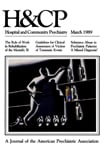Impact of Therapeutic Management on Use of Seclusion and Restraint With Disruptive Adolescent Inpatients
Abstract
Use of seclusion and restraint on three inpatient adolescent psychiatric units was examined during two five-month periods before and after implementation of a "therapeutic management" protocol. Under the protocol, staff classified disruptive behaviors into four stages and provided verbal and behavioral interventions to control behavior at each stage. Patients who required seclusion and restraint had significant latitude to determine the timing of their release from the interventions and met with staff one hour and 24 hours after their release to explore alternatives to aggression. The number of episodes of sedusion and restraint fell by 64 percent after the protocol was adopted, and the number of patients who required those interventions dropped by 39 percent. The mean duration of episodes of seclusion and restraint was reduced by 59 percent. Therapeutic management provides a corrective experience by addressing the developmental needs, deficient cognitive skills, and poor internalized controls of disruptive adolescents.
Access content
To read the fulltext, please use one of the options below to sign in or purchase access.- Personal login
- Institutional Login
- Sign in via OpenAthens
- Register for access
-
Please login/register if you wish to pair your device and check access availability.
Not a subscriber?
PsychiatryOnline subscription options offer access to the DSM-5 library, books, journals, CME, and patient resources. This all-in-one virtual library provides psychiatrists and mental health professionals with key resources for diagnosis, treatment, research, and professional development.
Need more help? PsychiatryOnline Customer Service may be reached by emailing [email protected] or by calling 800-368-5777 (in the U.S.) or 703-907-7322 (outside the U.S.).



